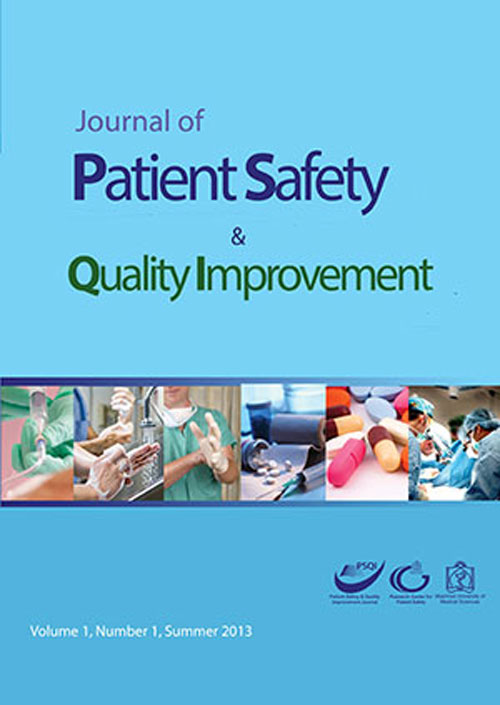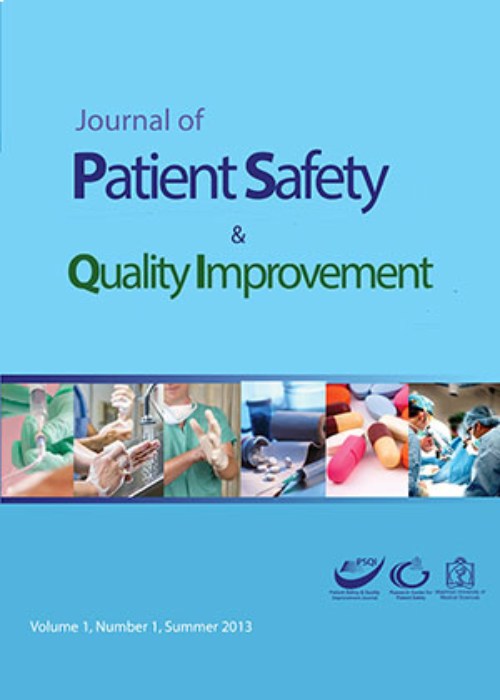فهرست مطالب

Journal Of Patient safety and quality improvement
Volume:7 Issue: 3, Summer 2019
- تاریخ انتشار: 1398/04/10
- تعداد عناوین: 8
-
Pages 81-86IntroductionThe lack of anthropometric data in the design of work stations and equipment can lead to injuries associated with work musculoskeletal disorders (WMSDs). Therefore, the aim of this study was to investigate anthropometric and postural evaluation of Nurse's aide in Selected Hospitals of Shahid Beheshti University of Medical Sciences.Materials and MethodsThis descriptive-analytic study was performed on the Nurse's aide working in the selected hospitals of Shahid Beheshti University of Medical Sciences. In this study the Body Map questionnaire was used to assess musculoskeletal disorders (MSDs) and discomfort, and QEC (Quick Exposure Check) software was used to evaluate posture. Finally, the data were analyzed using SPSS software version 21 using descriptive statistics, independent T test and Pearson correlation with 95% confidence level.ResultsThe mean age and work experience of the two groups of men and women were (38.17±9.48 and 37.44±9.51) and (14.27±9.51 and 12.06±8.34) respectively. The QEC score was unacceptable and the results showed that men are more at risk than women, although this was not significant (P = 0.082). In the majority of anthropometric dimensions, there was a significant difference between men and women (p<0.05). Also, the results showed that the highest and lowest incidence of discomfort was in the waist and hips areas respectively.ConclusionSignificant anthropometric differences were observed among men and women. Establishing anthropometric database of Nurse's aide in two groups of women and men and designing a work station suitable for anthropometric dimensions can reduce MSDs.Keywords: Nurse's aide, Anthropometry, postural evaluation, Musculoskeletal disorders
-
Pages 87-94IntroductionIn response to a serious incident involving an atrial fibrillation (AF) associated stroke, a quality improvement project was established to examine and improve all aspects of patient care for individuals presenting with acute AF to London’s North Middlesex University Hospital (NMUH).Materials andMethodsThe presenting complaint was examined for 2,105 consecutive medical admissions to identify 100 patients (4.7%) with acute AF. For each patient, 36 indices and performance indicators were collected and analysed against international standards. Deficiencies were identified in documentation, risk stratification, anticoagulation and arrhythmia management decisions. With cross-specialty collaboration, a single-page AF management algorithm was established using sequential PDSA methodology, and a further 100 consecutive patients with acute AF were analysed prospectively. A composite end-point of adverse outcomes (AF-associated readmission, stroke, cardiac death or major bleeding) was examined.ResultsAlgorithm implementation significantly reduced the proportion of patients exposed to unnecessary stroke risk (30% vs 4%, p<0.0001); improved identification and documentation of thromboembolic potential (50% vs 88%, p<0.0001), reduced incorrect drug decisions (12% vs 2%, p=0.01), reduced contraindicated rhythm control (8% vs 0%, p=0.007), and increased direct oral anticoagulant (DOAC) prescribing (38% vs 86%, p<0.0001) over warfarin. After a mean follow-up of 248 +/- 91 days, there was a significant reduction in composite adverse outcomes (22% vs 6%, p=0.0018).ConclusionUsing established quality improvement methodology and cost-neutral multi-disciplinary expertise, this novel management algorithm has significantly improved the quality and safety of care for patients with acute AF at NMUH.Keywords: Atrial fibrillation, Algorithm, Quality Improvement, Stroke
-
Pages 95-104Introduction
Patient-Reported Experience Measures (PREMs) are commonly used to indicate patients’ experiences in atrial fibrillation (AF) care. As outcomes are the primary goal in Value-Based Health Care, questions are raised regarding whether those experiences represent AF patients’ relevant outcomes. Therefore, this study aims to assess whether a questionnaire concerning AF patients’ experienced quality of care is correlated with AF patients’ clinical outcomes.
Materials and MethodsData of the present study originated from a prospective cohort study performed among outpatient AF patients in the Netherlands. In October 2015, all patients were asked to complete the Consumer Quality Index (CQI) to assess their experiences with the outpatient AF clinic. Analyses are performed to assess the association between patients’ experiences and clinical outcomes of AF patients (i.e. EHRA score) after three and six months of follow-up.
ResultsA total of 242 AF patients (68.7 years) met the inclusion criteria. Regarding the eight domains of the CQI, only provided information (B=3.10; p=0.01) and the physicians’ communication (B=-3.13; p=0.03) were associated with improved EHRA scores at three months. After six months, EHRA score improvements were associated with only one out of eight CQI indicators, namely the information AF patients received from other healthcare providers (B=-5.15; p<0.01).
ConclusionAn inconsistent correlation between AF patients’ clinical outcomes and AF patients’ PREMs was found. Although PREMs are relevant in healthcare, they cannot replace outcomes as a measure of medical care quality. For healthcare organizations, it is crucial to identify the required strategy for assessing the various aspects of the quality of services provided.
Keywords: Consumer Quality Index, patient-relevant outcomes, atrial fibrillation care -
Pages 105-109IntroductionDue to the importance of patient safety, it is necessary that health care providers have sufficient knowledge and positive attitude toward this issue. Therefore, current study aimed to evaluate the patient safety viewpoint among trainees in internship and residency programs in Kerman University of Medical Sciences (KUMS).Materials and MethodsA cross-sectional study carried out on 275 trainees in internship and residency in KUMS, 2018. The data collection tool was the Persian version of World Health Organization, Patient Safety questionnaire which evaluates medical students’ knowledge (7 items) and attitude (35 items) toward patient safety. The minimum and maximum score was 7 and 35 for knowledge and 30 and 150 for attitude section. Data analyzed by SPSS 19 using T-test, ANOVA, and multiple linear regressions.ResultsThe mean score of participants' knowledge was 19.63 which were significantly lower than the considered average. The mean score of participants' attitude was 97.33 which was considered higher than the average. Residents had higher knowledge and attitude scores compared to interns. A significant relationship was found between the knowledge score and age and the time spent in the current educational level.ConclusionOur study showed that knowledge and attitude of interns and residents was almost moderate toward patient safety. The residents had a higher attitude and knowledge than interns. This is probably due to more work experience and training courses provided at the beginning of the residency program. Therefore, it is imperative that patient safety topics be considered in medical curriculum planning.Keywords: Internship, Medical error, Patient safety, Residency
-
Pages 111-117IntroductionThe issue of managing and controlling pharmaceutical affairs is one of the most important affairs of the Ministry of Health and Medical Education. The aim of this study was to Survey the indexes of Principles of prescribing in Mashhad Medical Sciences Medical Centers and compare them with national indicators. It is hoped that by promoting the rational use of medicine, we will take a step towards a healthier and safe society.Materials and methodsThe present study is a Sectional. 77,964 prescriptions were reviewed of People referring to the centers covered by the Rural Family Physician Program in 2017. Data were analyzed by SPSS software version 21 and analyzed by T-test, one-way ANOVA and Chi-square. The level of significance was considered to be less than 5%.ResultsThe average of Medicines Per Prescription Was 2.51 ± 1.11. Antibiotics are among the most frequently prescribed medications by 44.9%, followed by NSAIDs with 20.77%. According to the results, 3.8% of prescriptions contained more than 4 drugs. The number of prescribed prescription drugs is higher for doctors with a higher employment status (P<0.01). Also, the number of drug items for older people is higher than for other age groups (P<0.01). The age of the patients is effective in the administration of antibiotics, in this study 69% of the children and adolescents who have received antibiotics are prescribed (P<0.01).ConclusionPrecise policies on the rational use of drugs are essential to facilitate the use of electronic health records and the launch of electronic prescriptions. Based on the results, there are scientific and educational interventions to promote the principles of rational drug administration.Keywords: Drug prescription, Family Physician, Iran, Rational Use of Medicine, Prescription
-
Pages 119-123Introduction
Exposure to Paraquat is usually fatal. Paraquat causes several organ failure and respiratory failure with pulmonary fibrosis. Therefore, doctors should get familiar with the approach to treatment and the prognosis of this type of poisoning.
Case report:An average age-old man admitted to Sabzevar Emergency Department after taking half a cup of herbicide during suicide attempt. He was fully alert and awake at the time of admission, complaining of epigastric pain. Significance of BP: 115/80 RR: 14 PR: 85 T: 37urin, the quality of urine was positive for paraquat. Hemodialysis was performed and continued due to the positive urine test for paraquat, and, in addition, the increase of urea, creatinine and oliguria that occurred on the second day after bursts. Increases in icteric and transaminases on the fifth day were observed. Abdominal ultrasound was normal. Respiratory distress developed on day 5 and deteriorated over time until it was intubated on the 11th day after admission. Prescribing cyclophosphamide and prednisolone was carried out on days 2 to 5 after reception.
ConclusionThe toxicity of paraquat remains with the use of hepatitis and immunosuppressive therapy. The doctor should be aware of the symptoms of this toxicity, the prognosis and treatment recommended is the goal of this study.
Keywords: Paraquat toxicity, Herbicide, Mortality, hemodialysis -
Pages 125-127Introduction
In this article, we report a case of penetrating chest trauma as a suicide attempt. Case
introductionA 40-year-old man complained of chest pain following a fall from a height (about three days ago). The patient refused to provide a complete history. After obtaining new and detailed patient's history from his father and reviewing his psychiatric file, it was determined that he performed trauma with the intention of committing suicide to his chest with a metal wire. There were two points of injury in his left hemithorax with infected crusts. Radiologic evaluation showed two foreign bodies in left hemithorax and hemothorax. Patient underwent surgery and finally was transferred to psychiatry unit.
ConclusionIt is important to get a detailed history of patients, especially those with mental disabilities and psychiatric disorders. Careful examination of these patients is recommended, even with the initial examinations. Key words: trauma, suicide, hemothorax, medical error
Keywords: Chest, Suicide, Trauma -
Pages 129-135ObjectiveThis study aims to evaluate the patient safety attitudes, skills, knowledge and barriers related to reporting a medical error from a nursing perspective in obstetric departments. Martials andMethodsA cross-sectional and descriptive study was conducted on a sample of 200 nurses and midwives. Patient safety attitudes, skills, and knowledge (PS-ASK) Scale was used to collect data from nurses.ResultsNurses had good knowledge and a positive attitude toward patient safety. However, the participants had higher scores in attitude than knowledge and skills. No significant difference was found between nurses and midwives regarding patient safety knowledge, attitude, and skills (p> 0.05). There are significant positive relationships between nurses' knowledge and a variety of safety attitude and skills (p < 0.05). The top three errors reported were: error during medication preparation and administration, failing to regularly monitoring of fetus's heart rate, and patient falls from beds or while walking without adequate supervision.ConclusionPatient safety is considered one of the important areas in the health care industry. In the current study, the overall safety knowledge and skills could be described as good but not sufficient. This could be attributed to a lack of sufficient training and education. Reporting errors is still a problem due to fear of consequences.Keywords: Knowledge, Attitude, Skills, Safety


